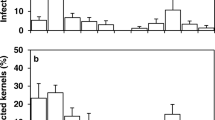Abstract
The flowering time is the most susceptible period for primary infection of wheat heads byFusarium spp. During this period spores can be deposited into the opened wheat florets where they may later cause infections. We quantitatively explored the relationship between variables related to the flowering process and the infection level byFusarium graminearum in single spikelets. We imitated open (chasmogamous) and closed (cleistogamous) flowering by injecting well-defined amounts of spores into and between wheat florets. Applying the spores between the florets resulted in weaker disease symptoms and significantly lower amounts ofFusarium mycotoxins. With larger numbers of spores, the disease symptoms became more pronounced and the mycotoxin amounts per spikelet increased significantly.
Our results indicate that the probability of primary infection is approximately proportional to the number of spores reaching the open florets during the flowering process. The breeding of wheat lines which flower partially or completely cleistogamously might reduce theFusarium susceptibility in wheat.
Similar content being viewed by others
References
Atanassov Z, Nakamura C, Mori N, Kaneda C (1994) Mycotoxin production and pathogenicity of Fusarium species and wheat resistance to Fusarium head blight. Can J Bot 72: 161–167
Anderson AL (1948) The development of Gibberella zeae head blight of wheat. Phytopathology 38: 595–611
Bai G-H, Shaner G (1994) Scab of wheat: prospects for control. Plant Dis 78: 760–766
Chhabra AK, Sethi S K (1991) Inheritance of cleistogamic flowering in Durum-wheat (Triticum-Durum). Euphytica 55: 147–150
De Vries APh (1971) Flowering biology of wheat particularly in view of hybrid seed production - a review. Euphytica 20: 152–170
Ellner FM, Schröer R (2001) Weizen: Gesunde Ähren und Spitzenqualität sind das Ziel. dlz-Agrarmagazin 4: 50–54
Engle JS, Lipps PE, Graham TL, Boehm MJ (2004) Effects of cholin betain and wheat floral extracts on growth of Fusarium graminearum Plant Dis 88: 175–180
Evans CK, Xie W, Dill-Macky R, Mirocha CJ (2000) Biosynthesis of deoxynivalenol in spikelets of barley inoculated with macroconidia of Fusarium graminearum. Plant Dis 84: 654–660
Grossmann K, Retzlaff G (1997) Bioregulatory effects of the fungicidal strobilurin kresoximmethyl in wheat (Triticum aestivum). Pest Sci 50: 11–20
Haidukowski M, Pascale M, Perrone G, Pancaldi D, Campagna C, Visconti A (2005) Effect of fongicides on the development of Fusarium head blight yield and deoxynivalenol accumulation in wheat inoculated under field conditions with Fusarium graminearum and Fusarium culmorum. J Sci Food Agric 85: 191–198
Keydel F (1972) Blütenbiologische Untersuchungen: 1. Die Offenblütigkeit verschiedener Winterweizensorten. Bayer Landw Jb 49: 688–701
Kang Z, Buchenauer H (2000) Cytology and ultrastructure of the infection of wheat spikes by Fusarium culmorum. Mycol Res 104: 1083–1093
Kang Z, Buchenauer H (2002) Studies on the infection process of Fusarium culmorum in wheat spikes: Degradation of host cell wall components and localization of trichothecene toxins in infected tissue. Eur J Plant Pathol 108: 653–660
Lepschy J (2000) Nachweis eines Pilztoxins (Deoxynivalenol) mittels HPLC und Nachsäu-lenderivatisierung. GIT Labor-Fachzeitschrift 3/2000: 275
Liang X, Chen X, Chen C (1981) Factors affecting infection of some winter wheat cultivars to scab disease caused by Fusarium graminearum. Acta Phytopathologica Sinica 11: 7–12 (cited in Parry et al. 1995)
Marasas WFO, Nelson PE, Toussoun TA (1984) Toxigenic Fusarium species: Identity and mycotoxicology. The Pennsylvania State University Press University Park PA
Nicholson P (1999) Recent developments in the study of Fusarium head blight in the UK. Mycotoxins, IRTAC Cycle de Formation, 12
Nirenberg HJ (1981) A simplified method of identifying Fusarium spp. occuring on wheat. Can J Bot 59: 1599–1609
Parry DW, Jenkinson P, Mcleod L (1995) Fusarium ear blight (scab) in small grain cereals a review. Plant Pathol 44: 207–238
Prelusky DB, Rotter BA, Rotter RG (1994) Toxicology of mycotoxins. In: Miller JD, Trenholm HL (eds) Mycotoxins in grain - Compounds other than Aflatoxin. Eagan Press St-Paul MN. 359–403
Pritsch C, Muehlbauer G, Bushneil WR, Somers DA and Vance CP (2000) Fungal development and induction of defense response genes during early infection of wheat spikes by Fusarium graminearum. Molecular Plant-Microbe Interactions 13 (2): 159–169
Pugh GW, Johann H, Dickson JG (1933) Factors affecting infection of wheat heads by Gibberella saubinetii. J Agric Res 46: 771–791
Savard ME, Sinha RC, Seaman WL, Fedak G (2000) Sequential distribution of the mycotoxin deoxynivalenol in wheat spikes after inoculation with Fusarium graminearum. Can J Plant Pathol 22: 280–285
Schroeder HW, Christensen JJ (1963) Factors affecting the resistance of wheat to scab caused by Gibberella zeae. Phytopathology 53: 831–838
Sethi K, Chhabra A K (1990) Cleistogamy in wheat. Rachis 9 (2): 34–36
Strange RN, Smith H (1971) A fungal growth stimulant in anthers which predisposes wheat to attack by Fusarium graminearum. Physiol. Plant Pathol 1: 141–150
Strange RN, Smith H (1978) Effects of cholin betaine and wheat extract on growth of cereal pathogens. Trans Br Mycol Soc 70: 193–199
Sutton JC (1982) Epidemiology of wheat head blight and maize ear rot caused by Fusarium graminearum. Trans Br Mycol Soc 70: 187–192
Takegami S (1957) On the relations between the existence of wheat anthers and the infection of Gibberella zeae. Proceedings of the Crop Science Society of Japan 26:31–32. Abstract, Review of Applied Mycology 1958. 37:155
Ypema HL, Gold RE (1999) Kresoxim-methyl. Modification of naturally occurring compound to produce a new fungicide. Plant Dis 831:4–19
Author information
Authors and Affiliations
Rights and permissions
About this article
Cite this article
Schuster, R., Ellner, F.M. Level ofFusarium infection in wheat spikelets related to location and number of inoculated spores. Mycotox Res 24, 80–87 (2008). https://doi.org/10.1007/BF02985285
Received:
Accepted:
Published:
Issue Date:
DOI: https://doi.org/10.1007/BF02985285




